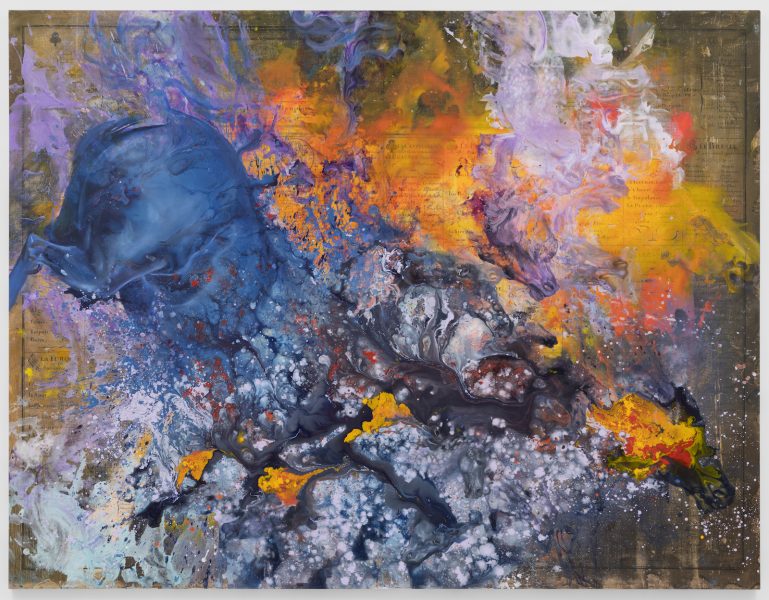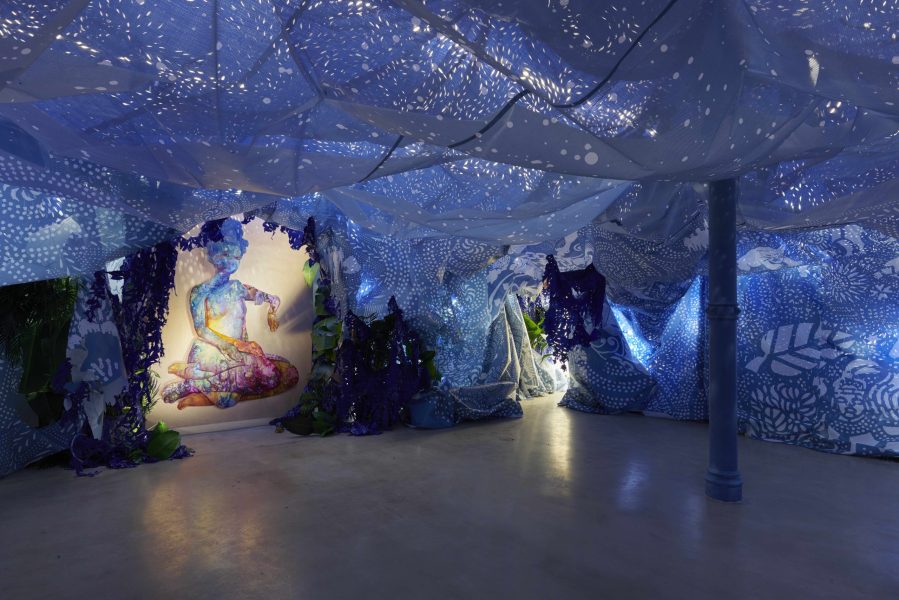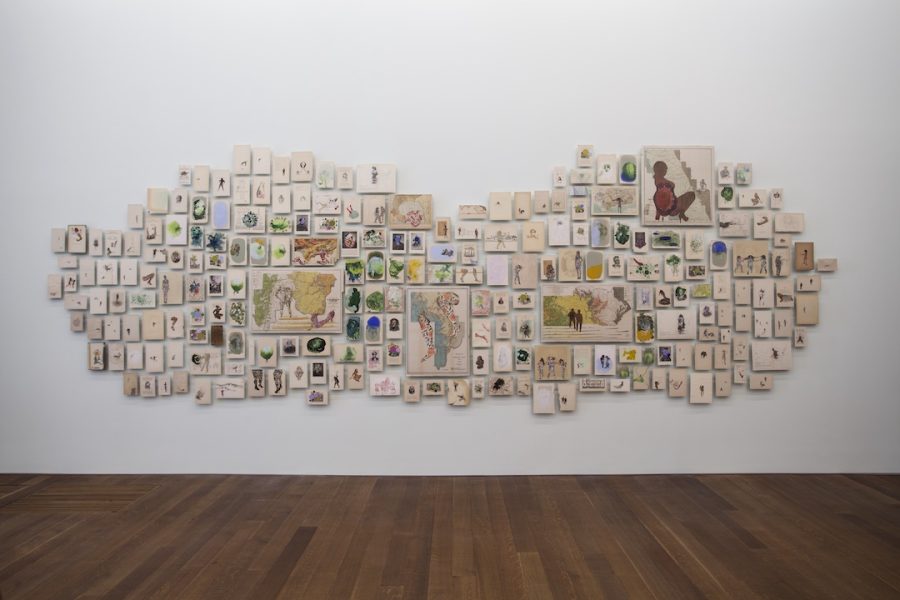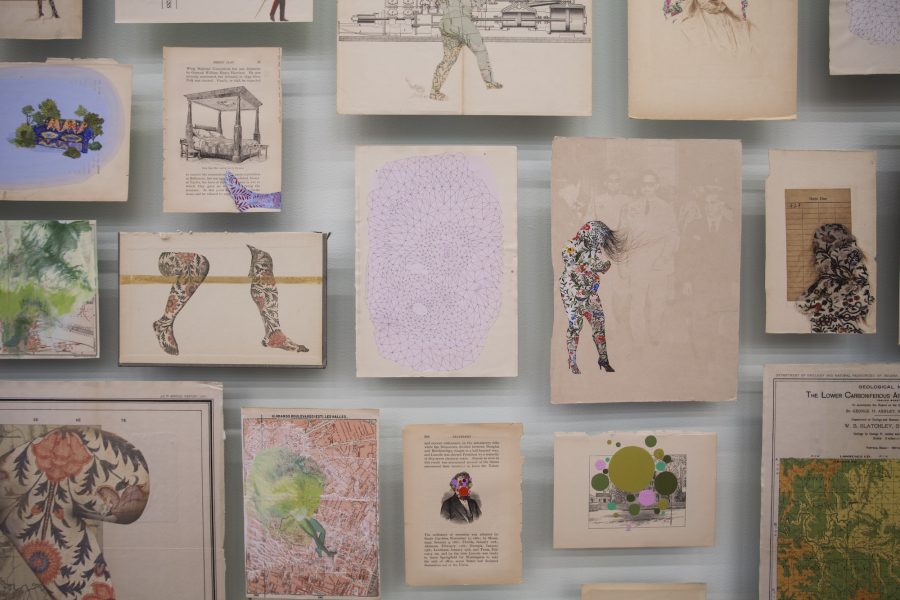Exhibition debuts works on view for the first time including a newly commissioned floor to-ceiling mural overlooking Boston Harbor.
(Boston, MA—FEB. 8, 2024) In April 2024, the Institute of Contemporary Art/Boston (ICA) presents Firelei Báez, the first North American museum survey dedicated to the richly layered work of Firelei Báez (b. 1981, Santiago de los Caballeros, Dominican Republic). The exhibition features 40 works that span nearly two decades of the artist’s practice and showcase Báez’s profoundly moving body of work exploring the complicated and often incomplete historical narratives that surround the Atlantic basin. The exhibition will premiere a new large-scale painting and site-specific mural in the ICA’s stunning Founder’s Gallery overlooking the harbor and responding to Boston’s colonial and marine history. Included in the exhibition are immersive, sculptural installations that give visitors the sensation of stepping into a world of Báez’s creation, and the largest number of her paintings gathered in one place to give audiences a full sweep of her career to date. On view from April 4 to Sept. 2, 2024 at the ICA, the exhibition will then tour throughout North America to the Vancouver Art Gallery (Nov. 2, 2024—Mar. 16, 2025) and the Des Moines Art Center (Jun. 14, 2025—Sep. 21, 2025). Firelei Báez is organized by Eva Respini, Deputy Director and Director of Curatorial Programs, Vancouver Art Gallery (former Barbara Lee Chief Curator at the ICA), with Tessa Bachi Haas, ICA Curatorial Assistant.
“Firelei Báez is part of a vital movement in contemporary art that embraces the role of art in understanding gaps in the historical record,” said Jill Medvedow, ICA Ellen Matilda Poss Director. “She delves into the historical narratives and fluid identities of the Atlantic basin in a way that invites audiences to reimagine and reassess. Firelei’s stunning, immersive installation at the ICA Watershed in 2021 left an indelible impression on all who saw it. This comprehensive survey will examine two decades of the artist’s practice, offering audiences a deeper and richer encounter with the work of this important artist.”
“This survey highlights Báez’s investment in the medium of painting and its capacity for storytelling and mythmaking,” said Respini. “Her work is about looking at history through multiple lenses – she shifts perspectives and creates layers of complexity where history has only provided a single perspective.”
Báez’s exuberant, colorful paintings feature complex and layered uses of pattern, decoration, and abstract gestures alongside symbols rooted in Caribbean culture. She paints overtop colonial maps or construction plans for colonial architecture to challenge our understanding of received power, history, and truth. To create her rich worlds, Báez draws on folklore, fantasy, science fiction and mythology. The mostly female figures that dominate her paintings are not easily identified – they seem to hover between human, animal, and myth. These figures can be understood as free from fixed historical categories, and as symbols of both struggle and renewal.
In Untitled (Les tables de geographie reduites en un jeu de cartes) (2022), Báez has conjured a stampede of horses in various states of abstraction. This painting began during a 2021-22 residency in Rome, where she encountered many heraldic sculptures and paintings of horses. Unlike the images Báez encountered in Rome, her horses are not agents of battle or royal conquest, instead they are unbridled, created through the artist’s process of rendering figures through poured paint. In this work, Báez responds to the game of colonial conquest. Underneath this painting are reproductions of a set of playing cards dedicated to the Grand Dauphin of France (1661-1711), the son of King Louis XIV (1638-1715). The cards include maps of Africa, America, Europe, Asia, each represented by a playing card suit. The face cards contain a medallion portrait of a different leader for each continent, providing information on the countries represented.
This exhibition begins with significant works on paper, featuring her considerable skills as a draftsperson. An early and important example of work on paper is Can I Pass? Introducing the Paper Bag to the Fan Test for the Month of July (2011), a series of 31 self-portraits displayed like a calendar for the month of July. The self-portraits detail only the artist’s eyes and silhouette as she poses with different hair styles for each day of the calendar month. All of the portraits are made to match the artist’s shifting skin tone as it darkens and lightens with changing seasons. This exercise is reminiscent of the racist practice of using the Brown Paper Bag Test to admit or deny entry to social functions based on one’s skin color in the 20th-century United States.
In Man Without a Country (aka anthropophagist wading in the Artibonite River) (2014-2015), Báez uses 225 pages sourced from late 19th-century architectural, engineering and art manuscripts sourced from The Cooper Union library, onto which she ruminates on the history of Hispaniola—the Caribbean island that is divided between the Dominican Republic and Haiti—in a global context. These form the support for her drawings depicting chimeric organisms, femme figurations, and decorative, symbolically charged embellishments. The markings intervene across the text, fusing folkloric motifs with academic writing to offer new ways of reading history and culture. Báez installs each page individually to form this wall-size installation, suggestive of island geographies and bodies of water, which viewers navigate according to their own trajectories, resisting singular narratives in favor of multiple readings.
Báez brings the powerful quality of her paintings into three dimensions with her sculptural installations. She creates generative spaces with painted architectural forms that invite new possibilities and ideas to be explored. A Drexcyen Chronocommons (To win the war you fought it sideways) (2019) is an immersive installation that invites audiences to reexamine historical narratives, echoing some of the same characteristics of her 2021 commission for the ICA Watershed. Báez envelops the space under a star map of the night of the onset of the Haitian Revolution and hand-perforated blue tarps, casting spots of light onto surfaces painted with symbols reflective of the Black diaspora, constructing a place where the past, present, and future intertwine.
Báez’s architectural sculpture (once we have torn shit down, we will inevitably see more and see differently and feel a new sense of wanting and being and becoming) (2014), is adapted from the Sans-Souci Palace in Milot, Haiti, built in the early 1800s for the revolutionary leader and first King of Haiti, Henri Christophe I. The Haitian Revolution, led by self-liberated enslaved people against the French colonial government, was an early precursor to the abolition movements of the United States. Once a space of militant splendor, since an 1842 earthquake the castle has been an archeological ruin. Expanding the painterly surface into an architectural dimension, visitors are welcome to walk through Báez’s archeological re-visioning. The patterning of the sculpture’s surface is largely drawn from West African indigo printing, a knowledge brought by enslaved peoples in the 17th century to the American South. American indigo was a driving force in the early national economy. This material became intrinsically woven into early American decorative and utilitarian textiles—a symbol of “true blue” Americana.
Visitors will reach the end of the exhibition in the ICA’s Founder’s Gallery with the artist’s site-specific, floor-to-ceiling mural. The vinyl mural will be visible from Boston Harbor and will engage with Boston’s colonial and marine history.
Publication
The exhibition will be accompanied by a richly illustrated catalogue featuring works in the exhibition, works from throughout Báez’s career, and essays from Leticia Alvarado, Katherine Brinson, Jessica Bell Brown, Julie Crooks, Daniella Rose King, Eva Respini, Hallie Ringle, and Katy Siegel.
Press Preview
Media are invited to attend the press preview for Firelei Báez on Tuesday, April 2, at 10am. RSVP to press@icaboston.org
Firelei Báez is organized by Eva Respini, Deputy Director and Director of Curatorial Programs, Vancouver Art Gallery, (former Barbara Lee Chief Curator, ICA/Boston), with Tessa Bachi Haas, Curatorial Assistant.
Major support for Firelei Báez is provided by Hauser & Wirth, the Henry Luce Foundation, and The Andy Warhol Foundation for the Visual Arts.
This project is supported in part by the National Endowment for the Arts, Karen and Brian Conway, David and Jocelyne DeNunzio, Mathieu O. Gaulin, The Kotzubei-Beckmann Family Philanthropic Fund, Lise and Jeffrey Wilks, an anonymous donor, the Jennifer Epstein Fund for Women Artists, and the ICA’s Avant Guardian Society.



